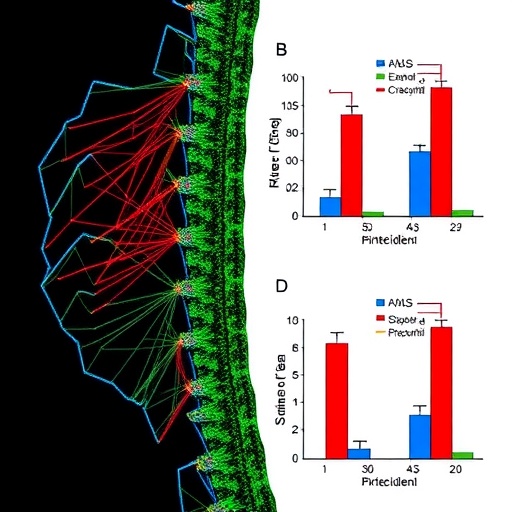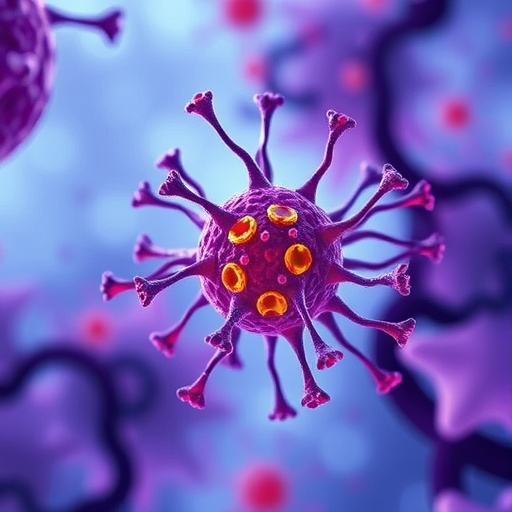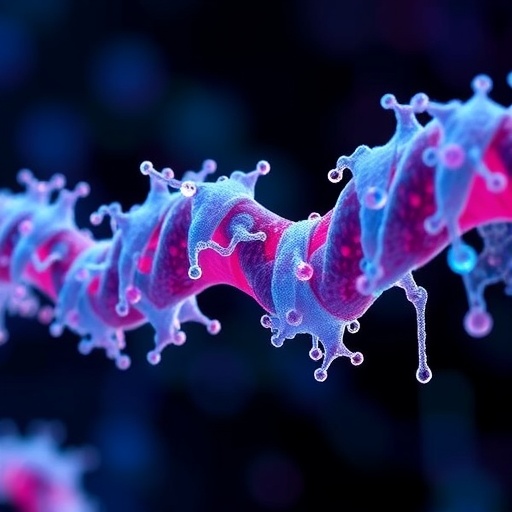In a groundbreaking new study set to redefine our understanding of nerve injury recovery, researchers have uncovered a novel protective mechanism within the spinal cord that could revolutionize treatments for severe nerve damage. The study, conducted by Mao, Lu, Wang, and colleagues, reveals that hydrogen sulfide (H₂S), a small gaseous signaling molecule traditionally known for its distinct odor and toxicity at high concentrations, plays a pivotal role in safeguarding spinal cord cells from an inflammation-driven form of programmed cell death called pyroptosis. This discovery could pave the way for innovative therapeutic strategies aimed at mitigating damage and enhancing recovery following lumbosacral plexus nerve injuries, which are notorious for their debilitating outcomes.
The lumbosacral plexus encompasses a network of nerves located in the lower back and pelvis, responsible for motor and sensory innervation to the lower limbs. Injuries to this intricate nerve cluster often lead to devastating impairments, including paralysis and chronic pain, with limited effective treatments available. The research team focused on the molecular underpinnings that drive secondary damage within the spinal cord following primary nerve injury. They identified pyroptosis—a highly inflammatory form of cellular death governed by gasdermin protein-mediated pore formation and subsequent cell rupture—as a critical factor exacerbating tissue damage and neurodegeneration post-injury.
Central to this protective mechanism is the process of protein persulfidation, a post-translational modification whereby sulfur atoms from hydrogen sulfide modify cysteine residues on target proteins, thereby altering their function. Using advanced molecular and biochemical techniques, the scientists demonstrated that H₂S mediates persulfidation of Rac1, a small GTPase known for its regulatory roles in cell signaling, cytoskeletal dynamics, and oxidative stress responses. This persulfidation event effectively inhibits Rac1’s pro-pyroptotic activity, thereby attenuating the cascade that leads to inflammatory cell death within the spinal cord.
The implications of modulating Rac1 through persulfidation are profound, as it expands the therapeutic potential of hydrogen sulfide beyond traditional paradigms. Importantly, the study delineates a mechanistic pathway where H₂S, via Rac1 modification, acts as a molecular brake on pyroptosis, protecting neurons and glial cells from the deleterious aftermath of nerve trauma. Such insights illuminate a promising avenue to enhance neural resilience following injury, which remains a crucial challenge in neurobiology and clinical neurology.
The authors utilized lumbosacral plexus nerve injury models to mimic the clinical scenario, allowing for detailed examination of spinal cord responses and the role of pyroptosis in secondary damage. Through histological analyses, molecular assays, and behavioral assessments, the team provided compelling evidence that hydrogen sulfide supplementation not only limits pyroptosis but also improves functional recovery outcomes. These findings underscore the dual role of H₂S as both a signaling molecule and a cytoprotective agent in the context of nervous system injury.
Mechanistic interrogation further revealed that the persulfidation of Rac1 by hydrogen sulfide leads to a reduction in reactive oxygen species (ROS) generation—a key driver of cellular stress and pyroptosis activation. This adds another layer to the protective profile of H₂S, as oxidative stress is a well-established contributor to secondary neuronal damage post-injury. By mitigating ROS levels, the pathway advises a broader neuroprotective strategy that could be harnessed for a variety of inflammatory and degenerative conditions within the central nervous system.
The study also navigates the intricate balance between inflammatory signaling and tissue repair, suggesting that targeted modulation of pyroptosis via H₂S can prevent excessive inflammation without completely inhibiting necessary immune responses. This nuanced approach holds promise for precision therapies that aim to support healing while avoiding chronic neuroinflammation, a problematic feature in many neurotraumatic and neurodegenerative disorders.
Interestingly, the protective effect of hydrogen sulfide is reminiscent of its emerging role in other physiological contexts, including cardiovascular health, where it similarly regulates inflammatory pathways and promotes cellular survival. The convergence of H₂S biology across different organ systems highlights the molecule’s versatility and therapeutic promise, further evidenced by this new data revealing its capacity to preserve spinal cord integrity after nerve injury.
The translational aspect of these findings is particularly exciting, as hydrogen sulfide donors or pharmacological agents that enhance endogenous H₂S production could be developed as adjunct therapies to standard surgical or rehabilitative interventions. Early therapeutic administration may significantly attenuate secondary spinal cord damage, improving patient outcomes by preserving neuronal circuitry and enhancing plasticity for functional restoration.
Moreover, the study opens several lines of inquiry into other molecular targets impacted by persulfidation, suggesting a richer network of H₂S-mediated protective mechanisms yet to be fully explored. Future research inspired by this work could expand our understanding of post-injury neurobiology and lead to multi-targeted treatments that synergize with existing neuroprotective agents.
The meticulous work by Mao and colleagues not only advances fundamental neuroscience but also aligns with a growing research trend emphasizing gaseous transmitters like nitric oxide, carbon monoxide, and hydrogen sulfide in regulating physiological and pathological processes. Their contribution provides a template for how modulation of protein function through post-translational modifications can be harnessed pharmacologically to control cell fate pathways in damaged neural tissue.
As the global health burden of nerve injuries continues to rise, innovations such as this offer renewed hope for patients facing chronic disability and impaired quality of life. The elucidation of hydrogen sulfide’s role in diminishing spinal cord pyroptosis after lumbosacral plexus injury adds a powerful tool to the therapeutic arsenal, inviting researchers and clinicians alike to rethink neuroprotection strategies through a molecular lens.
In summary, this pivotal study reveals a critical mechanism by which hydrogen sulfide confers protection against spinal cord pyroptosis via persulfidation of Rac1 following lumbosacral plexus nerve injury. By attenuating the damaging effects of inflammation-induced cell death, H₂S emerges as a promising molecular safeguard capable of preserving neural function and facilitating recovery. These findings chart an exciting course for future therapies aimed at harnessing endogenous gasotransmitters to combat complex neurotraumatic conditions.
The comprehensive molecular insights paired with functional recovery data underscore the translational potential of this approach and invite further clinical exploration. As the neurobiology community continues to unravel the complexities of injury response and repair, hydrogen sulfide’s unique bioactivity places it at the forefront of novel neuroprotective interventions, promising to reshape how we treat debilitating nerve injuries for decades to come.
Subject of Research:
Neuroprotection in spinal cord injury; Mechanisms of pyroptosis inhibition via hydrogen sulfide-mediated persulfidation of Rac1 after lumbosacral plexus nerve injury.
Article Title:
Hydrogen sulfide protects against spinal cord pyroptosis via persulfidation of Rac1 after lumbosacral plexus nerve injury.
Article References:
Mao, J., Lu, J., Wang, S. et al. Hydrogen sulfide protects against spinal cord pyroptosis via persulfidation of Rac1 after lumbosacral plexus nerve injury. Cell Death Discov. 11, 436 (2025). https://doi.org/10.1038/s41420-025-02736-x
Image Credits: AI Generated
DOI: https://doi.org/10.1038/s41420-025-02736-x
Tags: gasdermin proteins in cell deathhydrogen sulfide therapy for nerve injuryinflammation-driven nerve cell deathinnovative approaches to nerve regenerationlumbosacral plexus nerve damagenovel treatments for chronic painprotective role of gaseous signaling moleculespyroptosis in spinal cord injuriesRac1 persulfidation in nerve cellsspinal cord injury research advancementsspinal cord protection mechanismstherapeutic strategies for nerve recovery





